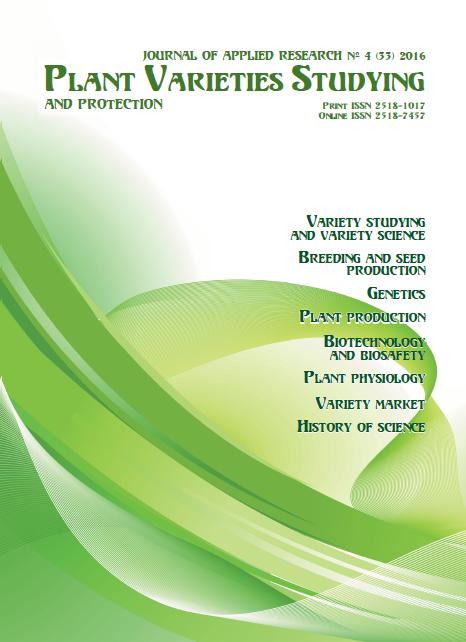Method for determination of varietal purity (typicality), hybridity, sterility of seed lots based on the establishment of the quantitative ratio of alleles of DNA markers
DOI:
https://doi.org/10.21498/2518-1017.4(33).2016.88678Keywords:
varietal purity, typicality, hybridity, sterility, DNA markers, SSR markers, quality control of seed lots, barleyAbstract
Purpose. To develop a conceptually new method for determination of varietal purity (typicality), hybridity, sterility of seed lots.
Methods of molecular biology (genomic DNA extraction, PCR with SSR markers application, capillary electrophoresis), genetic, statistical, mathematical analysis.
Results. New method for determining the varietal qualities of seed lot was developed that consists of the following steps: simultaneous DNA extraction from a representative sample of aggregated seeds; PCR and further analysis of the amplification products by determination of the qualitative and quantitative composition of SSR-markers’ alleles; calculation of values of varietal seed lot quality using experimentally derived allele ratios.
Conclusions. The developed method for determining varietal qualities of seed lots allows to reduce significantly the consumption of materials, time and labor during the analysis. Consistent qualification and quantification of alleles in the total sample of a seed lot is a conceptually new approach to establish varietal purity (typicality), hybridity, sterility.
Downloads
References
Leonova, I. N. (2013). Molecular markers: implementation in crop plant breeding for identification, introgression, and gene pyramiding. Vavilovskij Žurnal Genetiki i Selekcii [Vavilov Journal of Genetics and Breeding], 17(2), 314–325. [in Russian]
Sivolap, Yu. M. (2013). Molecular markers and plant breeding. Cytol Genet., 47(3), 188–195. doi: 10.3103/S0095452713030080
Newbury, H. J. (Ed.). (2003). Plant Molecular Breeding. Birmingham, UK: Blackwell Publ., CRC Press.
Rafalski, A. (2002). Applications of single nucleotide polymorphisms in crop genetics. Curr Opin Plant Biol., 5(2), 94–100. doi: 10.1016/S1369-5266(02)00240-6
Becker, J., & Heun, M. (1995). Barley microsatellites: allele variation and mapping. Plant Mol. Biol., 27(4), 835–845. doi: 10.1007/BF00020238
Edwards, D., & Batley, J. (2010). Plant genome sequencing: applications for crop improvement. Plant Biotechnol J., 8(1), 2–9. doi: 10.1111/j.1467-7652.2009.00459.x
Gut, I. G. (2001). Automation in genotyping of single nucleotide polymorphisms. Hum Mutat., 17(6), 475–492. doi: 10.1002/humu.1131
Sozinov, A. A. (1985). Polimorfizm belkov i ego znachenie v genetike i selektsii [Polymorfism of proteins and its importance in genetics and breeding]. Moscow: Nauka. [in Russian] Anisimova, I. N. (1987). Identification of varieties, lines and hybrids for the composition of helianthine polypeptides. Sbornik nauchnych trudov po prikladnoy botanike, genetike i selektsii [Proceedings on Applied Botany, Genetics and Breeding], 114, 114–126. [in Russian]
Syvolap, Yu. M., & Kozhukhova, N. E. (2005). DNA techniques in the registration and protection of plant varieties rights. Sortovivčennâ ohor. prav sorti roslin [Plant Varieties Studying and Protection], 1, 66–74. doi: 10.21498/2518-1017.1.2005.66849. [in Ukrainian]
Rybalka, O. I., Chervonis, M. V., & Lytvynenko, M. A. (2008). Genetic heterogeneity of wheat varieties developed in Odesa for allelic composition of GLI/GLU loci. Visnyk ahrarnoi nauky [Вulletin of Agricultural Science], 2, 54–59. [in Ukrainian]
Balvinska, M. S., Volkova, N. E., Kolesnyk, O. O., Solodenko, A. Ye., & Chebotar, S. V. (2015). Dyferentsiatsiia, identyfikatsiia, vyznachennia typovosti ta hibrydnosti silskohospodarskykh kultur za DNK-profiliuvanniam [Differentiation, identification, determination of typicality and hybridity of cultivated crops for DNA profiling]. Odesa: Astroprynt. [in Ukrainian]
Akinina, G. E., Terenyak, Yu. N., Sharypina, Ya. Yu., & Popov V. N. (2016). Genetic purity of seeds – actual question of modern genetics and plant breeding. Fakt. eksp. evol. org. [Factors in experimental evolution of organisms], 18, 56–60. [in Russian]
McPherson, M. J., & Moller, S. G. (2006). PCR (pp. 209–232). (2nd ed.). New York: Taylor & Francis Group.
Hoogendoorn, B., Norton, N., Kirov, G., Williams, N, Hamshere, M. L., Spurlock, G., … O’Donovan, M. C. (2000). Cheap, accurate and rapid allele frequency estimation of single nucleotide polymorphisms by primer extension and DHPLC in DNA pools. Hum Genet., 107(5), 488–493.
Parii, M. F., Vdovychenko, Zh. V., & Spyrydonov, V. H. (2011). Method for determining varietal purity and typicalness of lots of seed of farm crops using dna-markers. Ukraine patent for invention, МПК7 А 01Н 1/04. – No. u 2007 11049. [in Ukrainian].
Ramsay, L., Macaulaya, M., degli Ivanissevich, S., MacLean, K., Cardle, L., Fuller, J., … Waugh, R. (2000). A simple sequence repeat-based linkage map of barley. Genetics, 156(4), 1997–2005.
Keb-Llanes, M., Gonźales, G., Chi-Manzanero, B., & Infante, D. (2002). A rapid and simple method for small scale DNA extraction in Agavaceae and other tropical plants. Plant Mol. Biol. Rep., 20(3), 299a–299e.
Downloads
Published
How to Cite
Issue
Section
License
Copyright (c) 2016 Ukrainian Institute for Plant Variety Examination

This work is licensed under a Creative Commons Attribution-ShareAlike 4.0 International License.
Starting in 2022, the copyright to the publication remains with the authors
Our journal abides by the CREATIVE COMMONS copyright rights and permissions for open access journals.
Authors, who are published in this journal, agree to the following conditions:
- The authors reserve the right to authorship of the work and pass the first publication right of this work to the journal under the terms of a Creative Commons Attribution License, which allows others to freely distribute the published research with the obligatory reference to the authors of the original work and the first publication of the work in this journal.
- The authors have the right to conclude separate supplement agreements that relate to non-exclusive work distribution in the form in which it has been published by the journal (for example, to upload the work to the online storage of the journal or publish it as part of a monograph), provided that the reference to the first publication of the work in this journal is included.

























 Ukrainian Institute for Plant Varieties Examination
Ukrainian Institute for Plant Varieties Examination  Селекційно-генетичний інститут
Селекційно-генетичний інститут Institute of Plant Physiology and Genetics of the National Academy of Sciences of Ukraine
Institute of Plant Physiology and Genetics of the National Academy of Sciences of Ukraine
 The National Academy of Agrarian Sciences of Ukraine
The National Academy of Agrarian Sciences of Ukraine